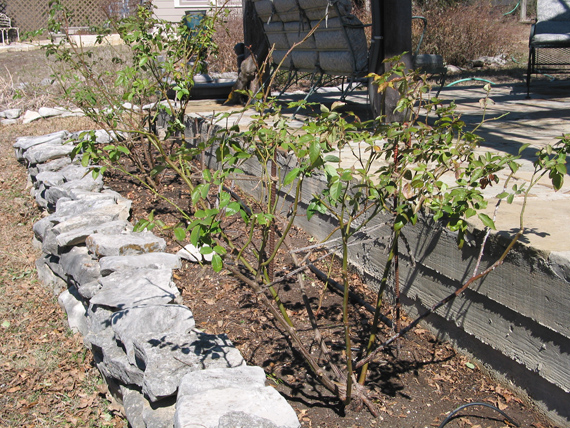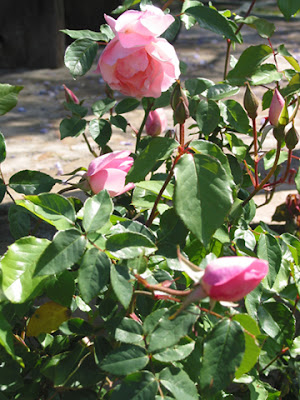
Hubby has been growing Belinda's Dream (above left) and Valentine (above right) varieties for many years with great success. I started a bed in recent years with Duchesse de Brabant roses (below), and they quickly earned my admiration.

The beauty of the Duchesse lies in its bright pink buds that open into fragrant, cabbagey-round flowers in ever-lighter shades of pale pink. This variety blooms almost continuously in central Texas. But, now it's time to prune.
There are many schools of thought on best pruning practices. So, I'll share what has worked well for my plants - not that 'antique roses' require much care to succeed. Pruning just helps encourage fuller foliage and heavier bloom, increases air circulation in the center of the bush - decreasing the risk for fungal disease. The time for pruning should be about two or three weeks before the final frost date (Valentine's Day here).
A good pair of gloves and sharp, curved-blade bypass shears is all that's necessary. (If you use the flat, anvil type of shears, you'll crush the canes, so stay away from those!) I also have some heavy-duty lopping shears on standby in case they are needed to cut the older, thicker canes.
As I go about my pruning, I clean the shears with alcohol swabs between working on each bush to keep any possible disease or pest from spreading from bush to bush.

|
| Before pruning. |
My rule of thumb is to clip back no more than 1/3 of the bush. Unbalanced growth, twigs and dead canes are removed, and interior growth is pruned so the remaining canes form a 'vase shape.' This is done by cutting any crossing stems at their base and trimming back others to just above an outward-facing growth bud (or eye).

|
| After pruning. |
Don't let the sparse results scare you. These bushes will thrive with lots of air circulation, healthy canes to support new blooms and better overall shaping. You may notice in these photos that three of my four rose bushes have been staked. No, that's not some new technique. It was necessary due to wind damage caused late last summer by a tropical storm that pushed my roses on their sides.
By mid-March these bushes will be filled with leaves and new buds just waiting to bloom. The pergola next to the rose bed will be covered with wisteria blossoms, and the bees and I will be intoxicated by the sight and smell emanating from this little spot on our property.
Such grand anticipation ...



0 comments:
Post a Comment